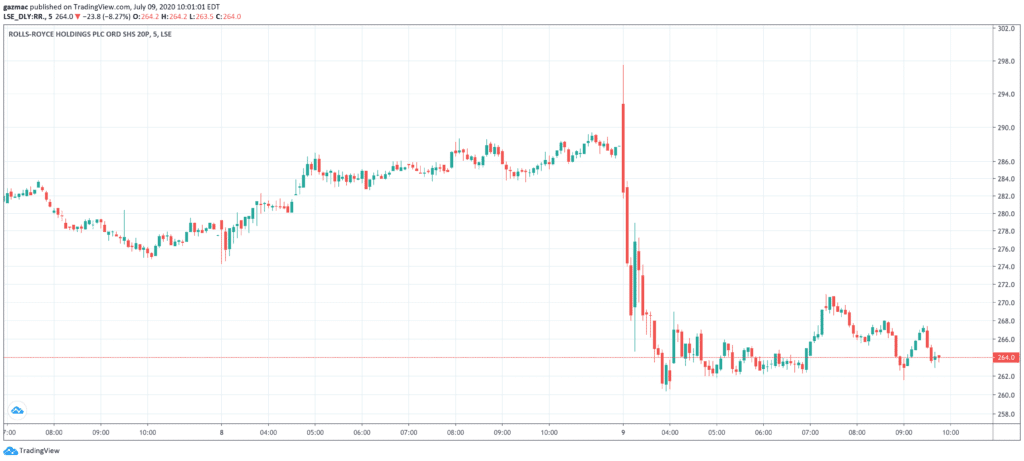
Rolls-Royce (RR) shares hit turbulence on the FTSE 100 today, dropping as much as 9% to 262p in early trading after news of a projected seven-year revenue hit on weaker wide-body engine sales.
In a trading statement released to the market this morning, the aero-engine maker’s chief executive Warren East said the coronavirus pandemic had inflicted an “historic shock in civil aviation which will take several years to recover”.
In a sign of the revenue squeeze it is facing, the firm is closing out a third of its $37 billion of dollar-denominated hedges. Global businesses such as Rolls-Royce take hedging positions in the foreign exchange markets to protect themselves against currency volatility.
With revenues plummeting – and not set to recover anytime soon – Rolls-Royce judges that it needs less hedging over the coming years.

Free cash flow cheers for bruised investors
Despite the substantial headwinds the engineering giant is wrestling with in its core wide-body engine business, East is still committed to realising £750 million in free cash flow by 2022.
That could be a tall order given everything else the company disclosed about its trading positions.
Top of the worry list must be the fact that engine fly time has collapsed 75% in the second quarter against an expected 55% over the full year.
In the current climate, savvy investors want to know about balance sheet strength, and weaknesses.
The weaknesses were there for all to see, but the company gave no guidance on how it intends to strengthen the balance sheet, aside from its stated aims of hitting the £750 million target on free cash flow.
So let’s take a closer at cash position.
Protecting the balance sheet
Closing out a third of its hedging positions will cost an eye-watering £1.45 billion, albeit over seven years.
Overall, Rolls-Royce expects to see £3 billion in cash draining from its balance sheet, with £3 billion of that disappearing in the first half.
Before today’s statement the company’s cash balance was a relatively healthy £4.2 billion.
On the plus side Rolls has a government guaranteed £2 billion five-year loan, courtesy of UK Export Finance, that should help to repair some of the damage to come.
The firm has already moved aggressively to cut its workforce, with 9,000 jobs set to go from a total of 52,000.
The restructuring and retrenchment programme is expected to deliver cost savings of around £1 billion this year.
Aside from securing the £2 billion UK Export Finance loan guarantee, Rolls gave no further indication of how it intended to strengthen its balance sheet, although it said it is reviewing its options.
An obvious route would be to raise funds through issuing new shares, but investors may struggle to muster much of an appetite for that given the dire forecast for future trading.
Share issue or share sales for Rolls-Royce?
Share sales are probably more likely and would be preferable to breaking up the company through the disposal of the profitable defence business.
And shareholders will already be acutely aware of the fact that the company actually loses money on every wide-body engine that it sells, so that makes the defence business a must-keep division.
With the government underlining its intention to protect strategically important businesses, Rolls is most definitely in the ‘too big to fail’ camp, so there’s no worries on the insolvency front.
The same goes for its biggest customers, the civil aviation aircraft-makers Boeing and Airbus, an additional safety blanket for the more nervous investors.
That said, continuing issues with Rolls-Royce’s Trent 1000 engine that goes into the Boeing Dreamliner, and the blow to revenue in previous years with Airbus discontinuing the A380, means the Rolls-Royce story has been mired in a narrative of near-perpetual crisis management. Let’s put it this way: it has been a while since RR was on stock-pickers’ best buy list.
Rolls-Royce shares investors will be encouraged
However, some of the figures the company put out today are actually relatively encouraging for Rolls-Royce shares looking ahead.
Admittedly engine flying time [measured in Engine Flying Hours – EFH] was down 50% in the first-half, across the industry as a whole in April, for example, air traffic was down a colossal 90%.
With long-haul flights beginning to pick up and engine delivery expectations still robust and the defence side of the business performing well, investors can see the possibility of light at the end of the tunnel.
Another tailwind for shareholders looking for comfort is the trend of older aircraft being retired sooner, which should benefit Rolls-Royce.
As investors digested the statement the shares have pared some of their losses, currently priced 7% lower at 266p.
With the shares losing 56% of their value since early March, Rolls-Royce watchers might reasonably be tempted to conclude that the only way is up from here.

Question & Answers (0)